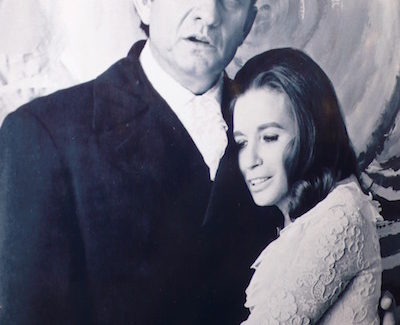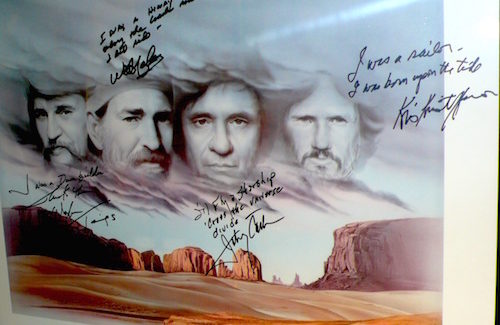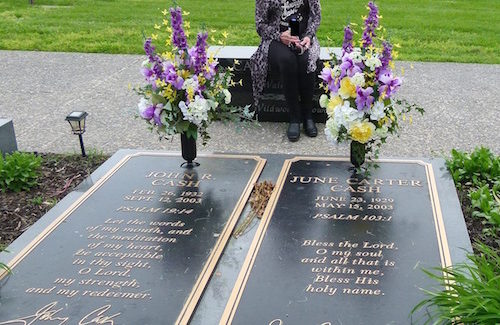Visiting Nashville: Johnny Cash Museum Honors ‘The Man in Black’
When Bill Miller was 13 years old, he went to a Johnny Cash concert that changed the course of his life.
“Johnny Cash played a harmonica and tossed it into the audience when he was done,” Miller said. “I caught it.”
That was just the beginning. Over the years, Miller collected a treasure trove of Johnny Cash memorabilia and became friends with the legendary entertainer. “I honestly can’t tell you how many pieces I have. It’s in the thousands.”
After Cash’s death, Miller decided to share his collection with the public as a tribute to “The Man in Black.” The Johnny Cash Museum opened in downtown Nashville in 2013 and has been drawing visitors ever since. It is within walking distance from where riverboats usually dock at the Nashville riverfront.
“People love the museum,” Miller said. “They feel a personal connection to Johnny Cash when they walk through these exhibits. It all comes back to the authenticity. His music speaks to people’s hearts. Johnny Cash had an incredible ability to connect to fans that identified with each song’s message.”
‘My love, my life’
For Marie Anderson of Cincinnati, the museum was a way to learn more about her favorite singer. “When I heard about this museum, I knew I had to come,” Anderson said. “It is even better than I hoped and I plan to come back once more before I leave Nashville.”
What she enjoyed most, Anderson said, was seeing items from Cash’s childhood and his marriage to June Carter Cash in 1968. “He only lived four months after she died in 2003. What he wrote on that box of Valentine candy he gave her in 1998 seems to say it all — ‘My Love, My Life, For Life.'”
Walking in his footsteps, visitors traverse exhibits from Cash’s life, including his hardscrabble childhood days in Dyess, Ark., his Air Force years, his famous prison concert tour, his TV and movie career, his marriage to June Carter, and his final days.
Items include four glass marbles that were among his few childhood toys, a Future Farmers of America card signed by a young J.R. Cash, a 12th-grade report card, an Air Force Bible, and a guitar with a dollar bill stuffed into the upper strings.
Because Cash’s band did not have a drummer until later, the dollar bill was used to simulate the sound of drums keeping a beat. You can hear this the most in the original recording of “I Walk the Line.”
The stone wall from Cash’s lakeside room in his Hendersonville house that burned was one of Miller’s biggest saves. Displayed in the museum, the stone wall commemorates the mind-boggling “guitar pulls” that Cash hosted with famous friends like Bob Dylan and Kris Kristofferson.
“The wall was removed stone by stone from the lakeside room,” Miller said. “After the house burned down, we wanted to allow fans to still see a part of the house, so we reconstructed it in the museum.
A sister remembers ‘J.R.’
As Johnny Cash’s youngest sister, Joanne Cash Yates remembers that her brother was determined to become a singer, despite the odds against him. “He said, ‘Baby, one day you’re going to hear me singing on the radio.’ I laughed at that. He always called me ‘Baby’ because I was the youngest girl.”
To Yates, however, her big brother was always J.R. “That was the name on his birth certificate. That’s what we always called him,” she said. “Mommy wanted to name him John after her father. Daddy wanted to name him Ray after himself. They couldn’t decide so they named him J.R.”
When Cash went in the Air Force, the government wasn’t going to allow a serviceman to have two initials for his name. “They told him that wouldn’t do. So J.R. said his name was John, and that’s what people started calling him. I guess Mom won after all.”
‘God has his hand on you’
Cash not only sang growing up, he also wrote songs, Yates said. “From the time I can remember, J.R. wrote songs and sang them … Mama would say often, ‘J.R., God has his hand on you. You will be great, and you will sing.'”
Church played a big part in the Cash family. “We’d go to church every Sunday morning, Sunday night, and Wednesday night,” Yates said. “We didn’t have any running water, but we took a bath every Saturday whether we needed it or not.”
At the museum, visitors can put on headphones and listen to Cash music from various decades, including one of his final hit releases before his death – the heart-rending video for “Hurt.” In it, the tormented still-powerful voice intones, “Everyone I know goes away in the end.”
Cash was 71 years old when the video was filmed in February 2003. He died seven months later on Sept. 12. Seen in the video sadly gazing at her husband, June Carter Cash died May 15, three months after filming.
“That is one of the saddest videos I have ever seen,” said Joe Mitchell, of St. Louis, removing museum headphones. “You can tell Johnny Cash knew he wasn’t going to live much longer, but he is still singing. He left us quite a legacy.”
For Miller, the museum was a labor of love, a tribute to the man he called a friend. “I was with Johnny about a week before he passed. I know he would love the museum.” Cash’s sister agrees. “Not long before J.R. passed away, he said to me, ‘Baby, when I’m gone, I wonder if anybody will really care,'” she said. “So I think he’d be real proud that this museum is here where people can come and remember him.”
Photos and story by Jackie Sheckler Finch

















View Recent Comments